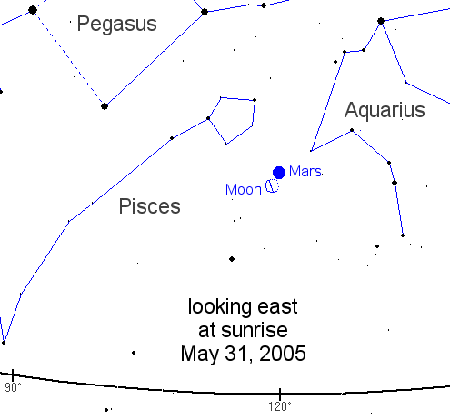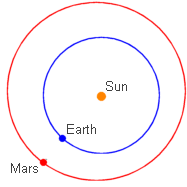|
Earth and Mars will have a breathtaking
close encounter in October 2005.
by Dr Tony Phillips
By the time you finish
reading this sentence, you'll be 25 miles closer to the planet Mars.
Earth is racing toward Mars at a speed
of 23,500 mph, which means the red planet is getting bigger and
brighter by the minute. In October, when the two planets are closest
together, Mars will outshine everything in the night sky except
Venus and the Moon. (You're another 50 miles closer: keep reading!)
It's only June now, but Mars is already
eye-catching. You can see it early in the morning, rising before
the sun in the eastern sky, shining almost twice as bright as a
1st-magnitude star. A sky map, below, shows where you could have
found Mars on Tuesday morning, May 31st, when it appeared beautifully
close to the Moon.
Why are we rushing toward Mars? It's
simple orbital mechanics. Think of Earth and Mars as two runners
on a circular race track, with lanes corresponding to planetary
orbits. Earth, running fast on the inside lane, circles the course
in 12 months. Mars, plodding along an outside lane, takes twice
as long to go around. Every two years, approximately, Earth catches
Mars from behind and laps it.

The
Moon and Mars on May 31st 2005
|
That's where we are now, approaching
Mars from behind. Relative speed: 23,500 mph.
We won't actually lap Mars until autumn,
October 31st at 0319 Universal Time, to be exact. Only 43 million
miles (69 million km) will separate us from Mars, then, compared
to an average distance of about 140 million miles (225 million kilometers).
It's a great time to send spacecraft there.

The
orbits of Earth and Mars.
|
Mindful of that, NASA plans to launch
the Mars Reconnaissance Orbiter (MRO) on August 10th, 2005. Because
it takes 6+ months to reach Mars, the best time to start the trip
is a month or so before closest approach - thus, August. MRO will
arrive in March 2006, enter orbit, and begin a 2-year mission to
map the red planet in greater detail than ever before.
The spacecraft's high-resolution cameras
will be able to discern objects, such as rocks and rovers and crashed
Mars landers, less than 1 meter across. A radar sounder will probe
for underground water while spectrometers map the distribution of
surface minerals. Other instruments will monitor the atmosphere,
teaching researchers back on Earth how to forecast martian weather.
These are key elements in NASA's plan to eventually send humans
to Mars.
The Mars rovers Spirit and Opportunity
are already there. They arrived in January 2004 on the heels of
another Earth-Mars close encounter in 2003. (Remember, this happens
every two years.) The two robots were supposed to stop working months
after they landed, worn down by wind, stuck in sand, or exhausted
by too little solar power. Credit NASA engineering: Spirit and Opportunity
are still rolling and, if they hold true to form, they'll be "alive"
to see Mars Reconnaissance Orbiter when it gets there, a tiny point
of light in the martian night sky, mapping the red planet for explorers
of the future.
| The
HiRISE camera onboard the Mars Reconnaissance Orbiter has
5-times better resolution than cameras on other Mars orbiters
and might be able to take pictures of the lost Mars Polar
Lander.
|
Back on Earth people are going to enjoy
watching Mars swell and brighten in the months ahead. By mid-summer,
amateur astronomers with backyard telescopes will be able to spot
polar ice caps and dust storms and strange dark markings. By autumn,
even the least attentive of your neighbors will be remarking on
"that bright red thing in the sky."
Mark October 31st as the best day of
all: Mars will rise at sunset, hang overhead at midnight, and "blaze
forth against the dark background of space with a splendour that
outshines Sirius and rivals the giant Jupiter himself." That's
how astronomer Percival Lowell described a similar close encounter
in the 19th century.
Can't wait? Don't. You can see Mars
any clear morning this summer. You missed Tuesday morning, May 31st
as Mars and the fat crescent Moon had a pleasing close encounter
in the dawn sky. Rising in the east around 4:30 AM. A sight guaranteed
to wake you up! But don't worry! There will be other opportunities.
How about trying tonight for instance?
More good news by the way... you're
now 1000 miles closer to the planet Mars.
|
